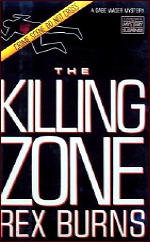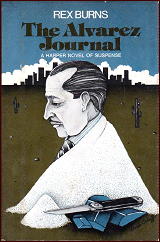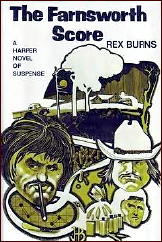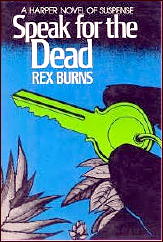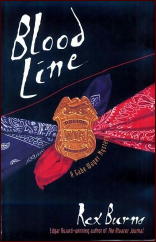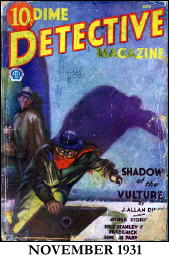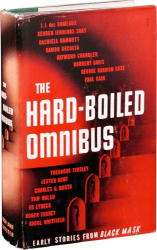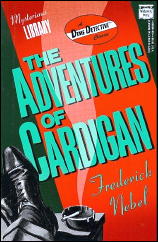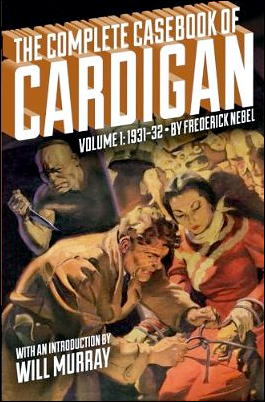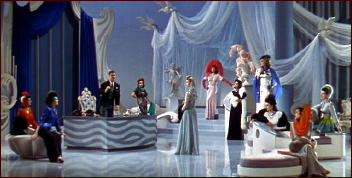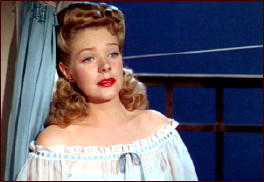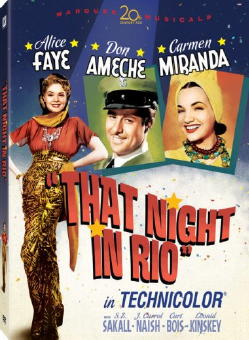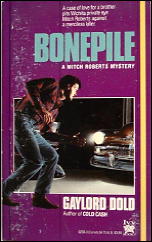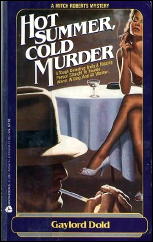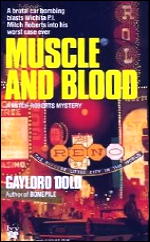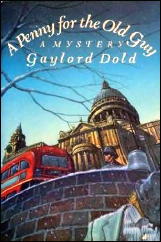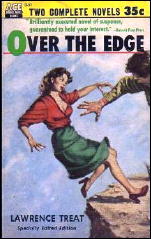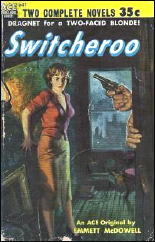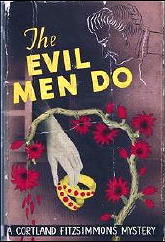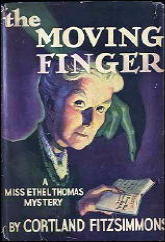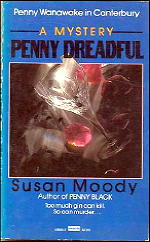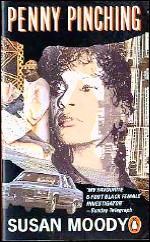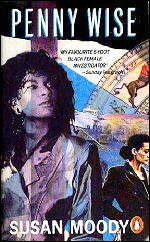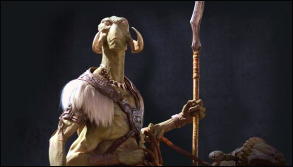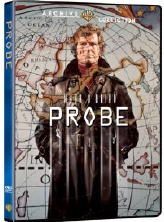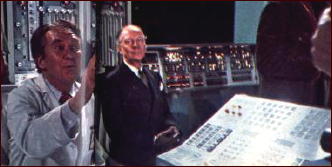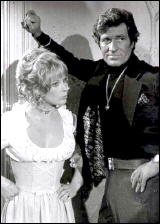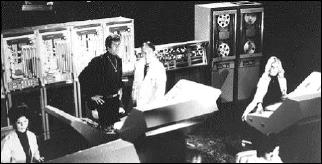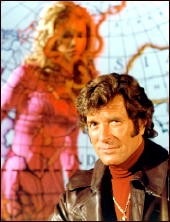A TV Series Review by Michael Shonk
BLUE LIGHT. ABC, 1966. Rogo Production in association with 20th Century Fox Television. Cast: Robert Goulet as David March. Christine Carère as Suzanne Duchard. Created by Walter Grauman and Larry Cohen. Executive Producer: Walter Grauman. Executive Script Consultant: Larry Cohen. Producer: Buck Houghton. Theme: Lalo Schifrin. Music Supervision: Lionel Newman.
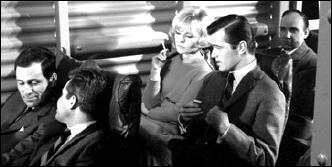
Blue Light is a forgotten TV spy series that, while not the equal, is worthy of mention with other TV spy series such as I Spy and Mission: Impossible.
Before the Nazis began their advance across Europe, America put eighteen sleeper agents inside Germany. One was American journalist David March. Only the few American government officials behind the Blue Light organization knew the truth, while the rest of the world believed March had betrayed his country and all he loved to join the Nazi war effort. In one episode March learned the woman he loved had committed suicide because of his support of the Nazi cause.
Occasionally the Nazis used March as a spy, but his usual role was writing and broadcasting propaganda. His underground contact was Suzanne, who fell in love with March as she posed as French Gestapo agent who hated him.
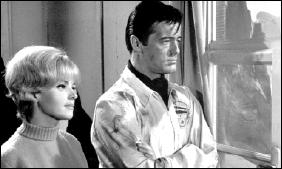
Considering the creative talent behind Blue Light, it is not a surprise the series was a gritty WWII spy drama with nourish touches. Larry Cohen is best known for his genre films such as Black Caesar, It’s Alive, and Maniac Cop. He also created the TV series Branded, Coronet Blue and The Invaders.
Walter Grauman is one of television’s iconic directors (Untouchables to Murder, She Wrote). He also won the Distinguished Flying Cross for his service as a fighter pilot in WWII Europe. There is an excellent interview of Walter Grauman by Stephen Bowie at the Archive of American Television. (Follow the link.)
The series did not pull any punches. Episodes featured dramatic examinations of moral issues as well as surprising twists and great action. March did not just knock out the guard as most TV good guys would. Instead, March did not hesitate to kill the guard with a knife in the back.
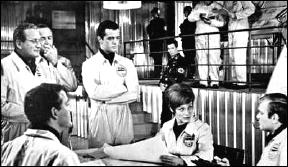
There were few easy solutions to the many choices March was forced to make. In one episode he was forced to choose between some citizens who had escaped a Nazi labor camp or getting a top secret Nazi weapon to the Allies in England.
Known more as a singer, Robert Goulet was surprisingly believable as David March, double agent. On the other hand co-star Christine Carère proved to be a liability to the series and weaken the possible romantic subplot. The guest stars included some of the best TV characters actors of the 60s, especially European actors on their way to America. (See the episode index below.)
The production was shot overseas at Bavarian Studios in Munich, Germany. According to an interview of Robert Goulart in Stars & Stripes (2/16/66), Blue Light was the first American TV series filmed in color in Europe.
The music soundtrack by Lalo Schifrin and others (including Pete Rugalo, Mullendore and David Gruson) was a special delight. Listen to episodes such as “Sacrifice!†and “Agent of the East†and you can hear occasional hints of Schifrin’s future work in Mannix and Mission: Impossible.
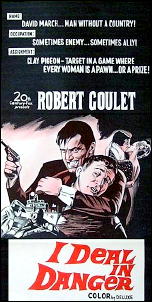
Blue Light had the potential to be something special, but it was limited by its half hour format. While the short time kept the action moving, it eliminated the opportunity to further develop the characters. The villains were often underdeveloped and weakened by the speed March outsmarted them.
It is best to watch the episodes in order. The first four episodes told the story of David March’s mission to destroy a top secret Nazi weapon base in Grossmuchen, Germany. “Return of Elm†and “The Secret War†are based on events in earlier episodes.
The first four episodes were linked together and released as I Deal in Danger (1966). I have not seen the movie version, but it is available on DVD. The series itself is available only in the collector-to-collector market.
EPISODE INDEX —
“The Last Man” (1/12/66). Written by Larry Cohen. Directed by Walter Grauman. Guest Cast: Werner Peters, John Ragin, John Alderson. â— The Nazis know about Blue Light, an American undercover spy ring of eighteen agents. Seventeen have been killed. Now, Captain Elm is out to get rid of the man he believes to be the last man of Blue Light, American journalist now Nazi propagandist David March.
“Target David March” (1/19/66). Written by Larry Cohen. Directed by Walter Grauman. Guest Cast: Edward Binns, Hans Reiser, Geoffrey Frederick. â— With Elm gone, March still needs to convince some Nazis he is loyal to the cause before he can be assigned to the top-secret weapon base in Grossmuchen. Meanwhile a British officer has sent in three commandos to kill the American traitor David March.
“The Fortress Below” (1/26/66). Written by Larry Cohen. Directed by Walter Grauman. Guest Cast: Eva Pflug, John van Dreelan, Peter Capell, Manfred Andrae. â— March gets the assignment he wanted, the top-secret weapon base. The base is buried 200 feet underground and while nearly impossible to sneak in, it is even harder to get out. Unable to sneak any weapons in, March must figure out how to destroy the base.
“The Weapons Within” (2/2/66). Written by Larry Cohen. Directed by Walter Grauman. Guest Cast: Eva Pflug, Horst Frank, Alexander Allerson, Dieter Eppler. â— The naïve female German scientist who had agreed to help March’s blow up the base has second thoughts when she is faced with causing the death of her friends at the base.
“Traitor’s Blood” (2/9/66). Written by Larry Cohen. Directed by Walter Grauman. Guest Cast: Jerry Ayres, Henry Beckman, David Macklin. â— March visits his younger brother being held in a Nazi POW camp. His brother had lied about his age to join the Army and prove he was not a traitor like his brother.
“Agent of the East” (2/16/66). Teleplay by Donald S. Sanford, story by Larry Cohen. Directed by James Goldstone. Guest Cast: Jan Malmsjo, Dick Davalos, James Mitchell. â— To keep the plans for a heavy water plant from Nazi scientists, March must get to a captured Russian spy being held in Gestapo headquarters.
“Sacrifice” (2/23/66). Teleplay by Dick Carr, story by Larry Cohen. Directed by William Graham. Guest Cast: Larry Pennell, Barry Ford, James Brolin. â— The Nazis want March to convince a kidnapped All American hero to talk. An Allied bomb hits the Gestapo jail trapping March, the hero and two Nazis underground with no hope of rescue.
“The Secret War” (3/2/66). Written by Larry Cohen. Directed by Walter Grauman. Guest Cast: Roger C. Carmel, Kevin Hagen, Gail Kobe, Fred Holliday, Gilbert Green. â— Two Russian agents, who knew the Russian agent from “Agent of the East,†threaten to expose March and Suzanne if he does not work for them instead of the Americans.
“Invasion by the Stars” (3/9/66). Teleplay by Jack Turley, story by Curtis Sanders. Directed by Gerd Oswald. Guest Cast: Francis Lederer, Curt Lowens, Jason Wingreen. â— Allies need Operation Sea Lion, Hitler’s planned invasion of England, delayed. March attempts to convince Hitler’s astrologist to advise Hitler to postpone the invasion.
“The Return of Elm” (3/23/66). Written by Larry Cohen. Directed by Robert Butler. Guest Cast: Werner Peters, Malachi Throne. â— Elm, the villain of “The Last Man†episode, is back. The one Nazi who knows March is an American agent, Elm escapes a British POW camp. Knowing the Nazis believe he is the traitor, Elm returns to Berlin to kill March and clear his name.
“Jet Trail” (4/6/66). Written by Dan Ullman. Directed by James Goldstone. Guest Cast: Philippe Nicaud. Tony LoBianco, Lamont Johnson. â— March poses as an American OSS officer to help the French resistance recover a top secret German jet engine from a crash.
“How to Kill a Toy Soldier” (4/13/66). Written by Merwin Bloch and Roger E. Swaybill. Directed by Leo Penn. Guest Cast: Michael Shea, Donald Losby, Greg Mullavey. â— An 11-year-old Nazi witnesses March kill a courier for the plans to every rocket site in Norway. March faces the choice of killing the child or exposing himself as a spy.
“The Deserters” (4/20/66). Writer: Curtis Sanders. Director: Gerd Oswald. Guest Cast: Ken Lynch, Stuart Margolin, George Backman, James Davidson. â— The Germans send March into battle posing as an American soldier. He is to learn what direction the Allied forces will take on the Italian front. A Gestapo agent travels with March to watch him.
“The Other Führer” (4/27/66). Written by Walter Brough. Directed by James Goldstone. Guest Cast: David Sheiner, Paul Carr, Jack Colvin. â— A German aristocrat seeks the Allies aid to overthrow Hitler. The Germans catch and execute the Allies’ agent sent to meet the aristocrat and send March in the Allies agent’s place.
“The Key to the Code” (5/4/66). Written by Brad Radnitz. Directed by Walter Grauman. Guest Cast: Hans Gudegast (Eric Braeden), Alex D’Arcy, Erik Holland. â— While in France to do a radio program, March and Suzanne learn the Germans have set a trap for an upcoming Allies Commando attack. The Germans have broken the underground code putting March and Suzanne at risk and unable to warn the Allies about the trap.
“Field of Dishonor” (5/11/66). Written by Jamie Farr and H. Bud Otto. Directed by James Goldstone. Guest Cast: Steve Ihnat, James Frawley. â— High-ranking Nazi General, who has long been suspicious of March’s loyalties, attempts to defect to the Allies.
“The Friendly Enemy” (5/18/66). Written by Harold Livingston. Directed by James Goldstone. Guest Cast: Mark Richman, Robert Doyle, Richard Carlyle, James Doohan, Mort Mills. â— March is ordered to kill a German scientist who is close to creating an Atomic bomb for the Nazis.
